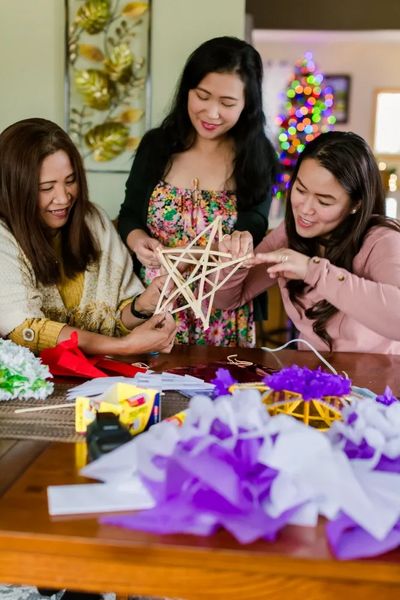.jpg?fit=outside&w=1000&h=667)
Bringing Christmas to Billings from The Philippines
December 2023
article & photos by lovely hitchcock
In the Philippines, I only remember two seasons: Summer and Christmas. As soon as September arrives, Christmas trees are decorated with ornaments that have been stored for less than a year. And because we also celebrate The Feast of the Three Kings on the first Sunday of January, Christmas lasts well into the New Year. With this long and unique holiday, it’s no wonder we have a lot of traditions!
I sat down with my Filipino friends, Mercy, Rea, and Glenda, and reminisced about our shared childhood traditions.
Rea smiles as she recalls that one of the first signs of Christmas is the radio stations playing Jose Mari Chan's "Christmas in Our Hearts” once September hits the calendar. And because Filipinos love music, Christmas caroling is one of the most popular traditions. As a kid, she and her peers would go door to door to sing, using improvised instruments like tambourines made of rusty aluminum wire and flattened bottle caps. She laughed when recalling how she and her friends would make up their own Christmas lyrics, especially when they didn't receive any donations after singing their hearts out. Living in the States, where this is not a tradition, no wonder Karaoke is a big part of their Christmas gatherings.
Glenda reflects on the nine-day Simbang-Gabi, aka the "night masses," which were long and tedious. But, as a kid, she looked forward to the fresh Christmas goods the local vendors sold, such as fresh rice cakes baked in banana leaves or steamed within bamboo tubes and hot cocoa made from natural cocoa. She talks about how the last mass, Misa de Gallo, was the most special one because it involved candle lighting and the re-enactment of the Nativity. The Belen is a very important symbol of Christmas because it shows how the Messiah was born surrounded by Mary, Joseph, the shepherds, their flocks, and the three kings.
In our one-season country, we had a thing called "aguinaldo," which means "bonus" in Spanish. Children would line up and greet their elders by taking their hand and lightly touching it to their forehead while saying "mano po." Usually, godparents are expected to give more aguinaldo to their godchildren; this is also when all families travel from all over the world to reunite. You can expect a joyful family reunion with parties, stories, games, and feasts! This is the one tradition that Mercy still carries with her; she practically became the godparent of the Filipinos in Billings. She makes sure that you get to have a family to celebrate Christmas with, which is why she wholeheartedly dedicates her time to putting together an annual local Filipino Christmas gathering.
But above all, Parol left a remarkable impression in their hearts. Parol comes from the Spanish word "farol," meaning lantern. It is the most iconic symbol of Christmas. It is shaped like a star made of bamboo and paper and comes in all different iterations and sizes. Parol represents the star of Bethlehem, which guided the three kings to the manger. It also symbolizes that light always overcomes darkness. Parols were lit with candles or coconut oil lamps in the past, and they were used to guide churchgoers during Simbang-Gabi. In the old days, people would hang their lanterns outside their windows for other villagers to admire their work of art. Eventually, this became a competition encouraged by the church; Spanish priests offered prizes for the best Parol. Over time, the Parol became more popular and represented goodwill. Parols today may not have the same innovation, artistry, and creativity as in the past, but Parol-making has become a source of income for many Filipinos.
Scroll onward for instructions to make your very own DIY Filipino Ornamental Lantern (Parol).
.jpg?fit=outside&w=1600&h=2400)
DIY Filipino Ornamental Lantern- Parol
.jpg?fit=outside&w=667&h=1000)
Filipinos are not just the largest exporter of nurses in the world or the pageant powerhouse, but they also celebrate this holiday with a joyful spirit. Their culture honors Christ’s birth like no other, and today, you will learn how to make a Filipino ornamental lantern or parol.
Supplies:
- 10 bamboo sticks
- Rubber bands
- Pegs
- Hot glue gun and glue sticks,
- Cellophane
- Tissue paper or washi paper
- Scissors
- Cardboard cut-outs
- String.
Instructions:
- Make a star with five bamboo sticks and tie each end with rubber bands. Make sure each point and space are equal and have the same length. Then, repeat the same process with the other five bamboo sticks.
- Combine the two stars by overlapping them and tie each point with rubber bands to secure the star.
- Carefully pull the center of the frame and place a peg on each pentagon. Secure each peg with hot glue.
- Cover each panel with cellophane, tissue, or washi paper. Use glue sticks to attach the paper to the frame. Cut off any excess paper as close to the frame as possible or glue the extra paper around the edge of the frame. Repeat until all panels are covered.
To make a tail for your parol:
- Fold a piece of paper into a triangle. Then, fold it again into a smaller triangle. Finally, fold it one more time to make it even smaller.
- Take the top corner of the triangle and fold it across the base. Using scissors, cut slits across the folded paper without cutting all the way through. Leave a half-inch space from the edge of the opposite side. Cut another slit one inch above the previous one without cutting completely. Start from the opposite side. Continue cutting slits from alternating sides of the triangle until you reach two inches below the tip. Then, cut a small hole at the end of the triangle. Carefully unfold the paper.
- Fasten a short piece of string in the center of each round cardboard cut-out. Insert the string through the hole at the tip of the tail. Attach the tail to the star by securing it with a string.
You can decorate your parol as you wish. Be creative and have fun!

Originally printed in the December 2023 issue of Simply Local Magazine
Never miss an issue, check out SLM's digital editions here!





